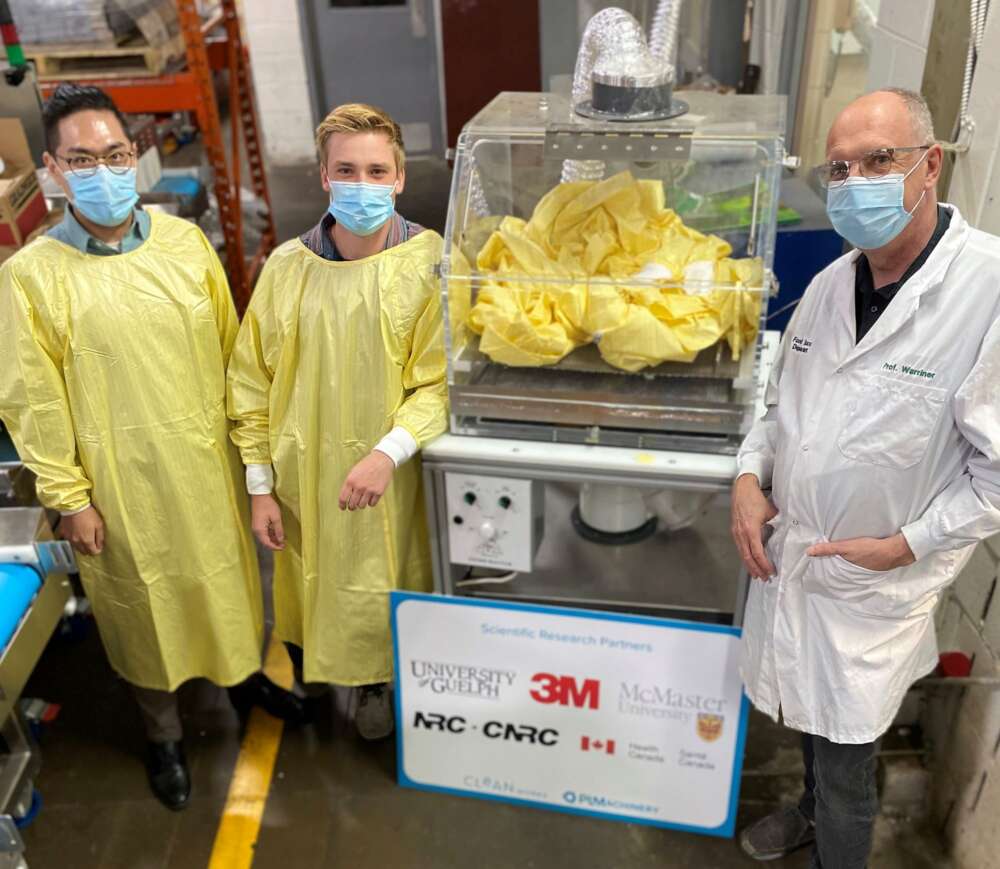
Decontaminating the COVID-19-causing virus and microbial pathogens from large batches of isolation gowns for reuse in hospitals and health centres across Canada is the goal of a new, provincially funded project involving University of Guelph researchers.
Using $25,000 received under the Voucher for Innovation and Productivity funding program of the Ontario Centres of Excellence, Prof. Keith Warriner and post-doc Mahdiyeh Hasani, Department of Food Science, aim to refine technology originally developed for cleaning produce to decontaminate isolation gowns from the coronavirus as well as other potentially lethal kinds of bacteria.
Warriner said the technology, called a forced air ozone reactor, is intended to help protect health-care workers as well as workers sorting hospital linens for cleaning. The process also promises to help save on costs of conventional laundering of the material.
Each day, hospitals use thousands of isolation gowns for routine patient care, and the pandemic is causing surges in demand.
“There’s a concern that these gowns coming from hospitals can carry the COVID-19 virus,” Warriner said. “This ozone technology could replace washing and save not only energy and water but also increase the throughput of gowns long after the pandemic is over.”
The proposed cleaning technology is not intended for heavily stained surgical gowns, which still require washing.
The process uses forced air to blow ozone through to blow ozone through batches of gowns contained in tote boxes inside a metal chamber. The stainless-steel reactor units are normally used to decontaminate up to 500 kilograms of produce, notably apples and peaches, at a time.
Warriner’s project partners include Clean Works Corp., based in Beamsville, Ont. This past spring, he worked with the company to adapt a different produce-cleaning technology to decontaminate N95 masks used to protect health-care workers from the coronavirus that causes COVID-19. The company’s Clean Flow units are now being used in about 70 health-care facilities.
Clean Works and Hamilton-based project partner Mohawk Medbuy Corp. asked Warriner to investigate the use of ozone for cleaning personal protective equipment (PPE). His tests in a lab-scale reactor showed that the process effectively reduced E. coli and Staphylococcus aureus, both potential infection-causing microbes in hospitals.
Although the team hasn’t specifically tested effects on the coronavirus, Warriner expects that the treatment will also kill it. “The virus is more sensitive than either of those bacteria. We know from our experience with Clean Flow systems that if there’s a reduction of E. coli, there is a more than 10-fold reduction of the virus.”
Under the new project, he will help refine the process, including determining optimum gown loads and ozone concentrations and flow rates.
Mohawk Medbuy launders linens arriving at depots from nearly 50 health-care sites nationally, including about 120,000 isolation gowns per week.
Colin Lyons, vice-president of the organization’s linen division, said the proposed forced air ozone technology would would help in meeting higher demand for PPE cleaning during the pandemic.
Isolation gowns make up about 12 per cent of the organization’s volume, said Lyons. “This forced air ozone process would reduce our utility consumption in natural gas and water by a similar percentage.”
Contact:
Prof. Keith Warriner
kwarrine@uoguelph.ca